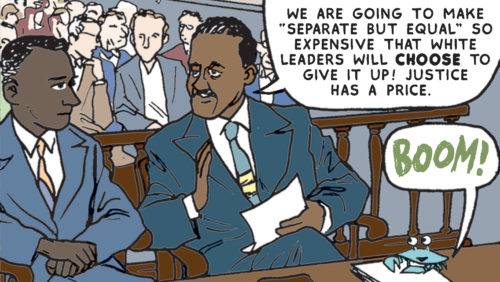I actually love hacking my old cartoons to pieces.
I’ve been doing that a lot in the past three years, to transition Chester the Crab’s adventures from the printed page to mobile digital devices. Chester’s library of digital stories is now available for Android devices and for the Kindle Fire. Don’t panic — I plan to keep at least 30 titles in print even as I dig hard to put more of his adventures onto the screens where today’s students are reading. Adding Chester’s stories to smartphones and tablets just makes good business sense. The revelation here is how interesting the transition process is to me as an artist/writer/educator/historian.
My dad was an Artist, capital A. He had gallery shows and sold his original pieces. A painter or sculptor doesn’t have an editor beyond their own personal sense of mission. Having an editor is the exact OPPOSITE of the freedom an Artist needs to pursue self-expression and challenging themes. But I am not an Artist. My art is very functional and directed — it has a purpose that is fitted to my writing and my educating, like parts of a rocket that must work together to get the rocket to a specific place. I need editors to get the rocket there in the best way possible. I trained to be a journalist, so for decades I have practiced and welcomed the dynamic between an editor and a creator.
If you think your art can be edited, that means it can be changed for the better. I am terribly proud of the work I did for the Daily Press in Virginia when I created Chester in 1995 and then produced daily educational comix from 1999 to 2004. But it was also a mad dash through a burning forest to get all those stories researched, written, rough drafted, edited, drawn, colored and edited again. Fellow cartoonists couldn’t believe my workload to get the stories into print on a newspaper schedule. Looking back now, 15 years later, some of those stories hold up really well. Some DON’T!!! Some of the art is painful for me to look at. And I’ve learned a lot more about many of these historical topics in the time since I drew for the Daily Press.
So instead of it being painful to take these big pages of cartoons and hack them down into little horizontal panels for little screens, this editing work to put Chester’s old stories onto mobile devices actually feels like FREEDOM, in my own framework of making art. This transition work completely challenges my storytelling skills and makes me rethink the point of each panel. The rethinking is so revolutionary that they feel like completely new stories. Woody Guthrie kept reworking “This Land is Your Land” throughout his life, so if Woody can do it, I can do it.
Some of the changes will be unnoticeable to most readers: I have literally found commas that were backwards! Other changes may be noticeable to the sharp-eyed fans: as a writer, I’ve enjoyed trimming a word here and a word there to make the comix storytelling smoother and tighter and more expressive; when I trim a word or two, I often redraw the word bubble so the spacing is balanced again; that leads to a little bit more image in the panel. I can feel the art breathing better. Comix is like alchemy — there is a magic to getting just the right balance of words and pictures in each panel and across a whole page. Some of my old pages for the newspaper version of Chester were WAY OFF that balance as I rushed to cram educational information in.
A lot of the changes will be wildly obvious to longtime Chester readers — these apps have stories with entirely new panels!! But just as significant has been the turn of the images from vertical to horizontal. My space in the newspaper was vertical, so my storytelling was oriented that way. Now I’m recutting panels so that the stories are always read by holding the phone or tablet sideways. That seems to fit the flow of historical storytelling better — racing across the timeline as you swipe from panel to panel easily. Plus, Chester is wider than he is tall, anyway.
If you still want to see Chester’s adventures in the exact way they were first drawn, you can buy them as iBooks for an iPad. And when we get to holograms, I’ll figure out how to tell the stories there, too.
This entry was posted on Sunday, January 29th, 2017 at 10:15 am and is filed under Author's Purpose, Comix Creation. You can follow any responses to this entry through the RSS 2.0 feed. Both comments and pings are currently closed.


















